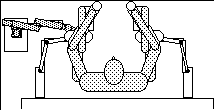Investigators: Charles G. Burgar, MD and Peter S. Lum, PhD Project Staff: H.F. Machiel Van der Loos, PhD; Peggy Shor, BS OTR; Matra Majmundar, OTR TYC; Douglas F. Schwandt, MS; and James H. Anderson, JEM Project Category: Stroke - 2000 Each year 400,000 people in the United States survive strokes, such that the number of stroke survivors now approaches three million. The estimated cost exceeds $7 billion per year for rehabilitation and lost revenue. Persons with hemiparesis following stroke constitute the largest group of patients receiving rehabilitation services in this country. World War II veterans now constitute the largest proportion of persons eligible for health care in VA facilities and most of these subjects are over 65 years of age and at increased risk for stroke. In anticipation of the needs of our rapidly aging veteran population, research efforts that improve the effectiveness of rehabilitative treatment of motor disability resulting from stroke are needed. With the dramatic reduction of inpatient rehabilitation length of stay following stroke, efficient and effective interventions have become critical. Our long-term objectives are to understand the mechanisms of motor impairment following neurological injury and to develop interventions to improve motor recovery. In this study, we will apply our experience treating chronic movement deficits using robotics to subacute rehabilitation. A clinical trial will validate and optimize the use of robot-assisted upper limb therapy for neuro-rehabilitation. With VA RR&D support, we have developed a robotic system (MIME) that assists or resists elbow and shoulder movements in three-dimensional space. In addition to unilateral exercise modes, a novel bimanual mode enables hemiparetic subjects to practice mirror-image upper limb exercises. The therapeutic efficacy of MIME has been established in chronic stroke subjects. In this study, we will determine whether our approach to robot-assisted therapy, when delivered in the subacute recovery period (1-2 months post-stroke), can reduce long-term disability. Interventions initiated in the very early stages following stroke (but beyond the time when intensive therapy may be detrimental), have the potential to affect the best recovery. In addition, we will identify the essential features of the robot therapy. We will determine if functional outcomes are greatest in subjects who receive only bimanual mirror-image exercise, only unilateral robot-assisted exercise, or a combination. We will also determine the added value of each of these three treatments relative to current therapeutic practice. We believe the bimanual and unilateral exercise modes complement each other in promoting neurological recovery, with the unilateral exercise promoting strength increases and the bimanual exercise decreasing abnormal co-contractions. Understanding the specific impairments the exercise modes are affecting is critical for effective integration of robot-assisted exercise into stroke therapy. Progress to Date: Preparations for this clinical trial are near completion. Project staff are undergoing certification examinations for the battery of clinical evaluations we will use. The MIME system has been modified to allow a single therapist to run all robot therapy sessions. Biomechanical evaluations are being upgraded by incorporating the Biodex system for strength testing and the Qualisys video motion analysis system for recording reaching movements. Funding Source: VA RR&D Merit Review |
